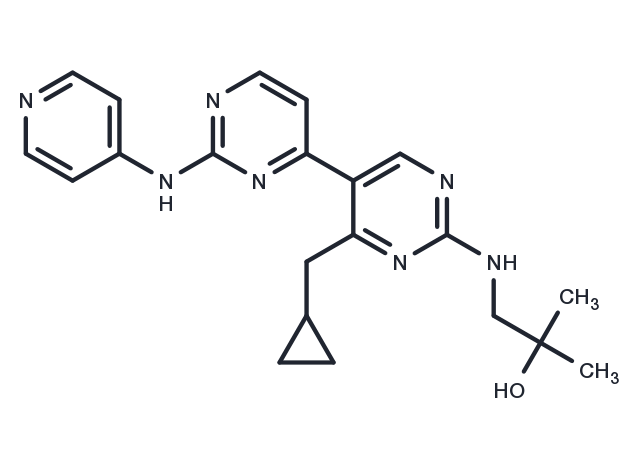Powder: -20°C for 3 years | In solvent: -80°C for 1 year


VPS34 inhibitor 1 (Compound 19, PIK-III analogue) (PIK-III analogue) is a potent and selective inhibitor of VPS34( IC50 : 15 nM)

| Pack Size | Availability | Price/USD | Quantity |
|---|---|---|---|
| 1 mg | In stock | $ 97.00 | |
| 2 mg | In stock | $ 123.00 | |
| 5 mg | In stock | $ 223.00 | |
| 10 mg | In stock | $ 343.00 | |
| 25 mg | In stock | $ 579.00 | |
| 50 mg | In stock | $ 829.00 | |
| 100 mg | In stock | $ 1,150.00 | |
| 1 mL * 10 mM (in DMSO) | In stock | $ 223.00 |


| Description | VPS34 inhibitor 1 (Compound 19, PIK-III analogue) (PIK-III analogue) is a potent and selective inhibitor of VPS34( IC50 : 15 nM) |
| Targets&IC50 | VPS34:15 nM |
| In vitro | VPS34 inhibitor 1 (Compound 19, PIK-III analogue) is extraordinarily selective over other lipid and protein kinases. The ability of compound 19 to prevent the degradation of autophagy substrates p62, NCOA4, NBR1, NDP52, and FTH1 is similar to PIK-III. In addition, treatment of cells with compound 19 leads to an increase in the lipidated and nonlipidated forms of LC3 similar to previous reports using PIK-III. |
| In vivo | The pharmacokinetic profile of analogue 19 is determined in C57BL/6 mice.?After oral administration at 10 mg/kg, the compound is rapidly absorbed and showed moderate mean systemic clearance (30 mL/min/kg, approximately 33% of hepatic blood flow), with good oral bioavailability (F% = 47).?Based on these PK parameters and the cellular activity, compound 19 constitutes a suitable candidate for in vivo studies.?Upon oral administration of compound 19 at 50 mg/kg twice a day (BID) for 7 days, LC3-II accumulates consistent with reduced autophagic capacity in time-dependent manner.?It inhibits autophagy in vivo. |
| Cell Research | Cell lines: U2OS cells.Concentrations: 0, 1, 5, 10 μM. Incubation Time: 24 h .Method: For inhibitor assay, cells are plated and the following day when cells had reached 90%, are treated with dimethyl sulfoxide (DMSO, vehicle) or the indicated concentration of PIK-III or Compound 19, both dissolved in DMSO. 24 hours later, cells are lysed in RIPA supplemented with 1% SDS and mini-EDTA protease inhibitors, homogenized by passage through a Qiashredder column and the protein is quantified by DC Lowry protein assay. |
| Animal Research | Animal Models: C57BL/6 Mice. Formulation: PG (20% v/v). Dosages: 10 mg/kg(p.o.) or 2 mg/kg(I.V.) .Administration: oral administration or I.V. |
| Synonyms | PIK-III analogue |
| Molecular Weight | 391.47 |
| Formula | C21H25N7O |
| CAS No. | 1383716-46-8 |
Powder: -20°C for 3 years | In solvent: -80°C for 1 year
DMSO: 78 mg/mL (199.25 mM)
You can also refer to dose conversion for different animals. More
bottom
Please see Inhibitor Handling Instructions for more frequently ask questions. Topics include: how to prepare stock solutions, how to store products, and cautions on cell-based assays & animal experiments, etc.
VPS34 inhibitor 1 (Compound 19, PIK-III analogue) 1383716-46-8 PI3K/Akt/mTOR signaling PI3K inhibit VPS34 oral VPS-34 inhibitor 1 (Compound 19, PIK-III analogue) Inhibitor VPS34 inhibitor 1 (Compound 19, PIK III analogue) lysosomal Compound 19, PIK-III analogue degradation Phosphoinositide 3-kinase PIK-III analogue selective VPS34 inhibitor 1 (Compound 19, PIKIII analogue) Autophagy VPS34 inhibitor 1 inhibitor
